With its emphasis on time efficient and tough work outs High intensity interval training (HIIT) has risen to popularity with regular gym goers and the self proclaimed I hate the gym gymers alike. The benefits of high intensity training are well documented for improving cardiovascular fitness changing body composition, increasing metabolism (your resting energy consumption) and getting a great hit of endorphins release for that feel good factor of getting though a brutal work out. Armies across the world have used the same style high intensity training for decades to get recruits fighting fit.
So with with great health benefits in a short amount of time whats not to like? Well, as with all forms of exercise there comes an element of injury risk. Of course these risks are not exclusive to HIIT work outs but the high intensity nature of HIIT classes and the type of exercises that are often included can make participants prone to injury. Here we look at the top 3 injures that we as therapists see in our clinic that come as a result of HIIT classes and some simple steps to reduce the risk of injury.
Lower back pain
Lower back pain is probably the most common issues that presents in physiotherapy clinics full stop but there are also many cases of lower back injures that occur during exercise classes. Many of the exercises that are included in these classes such as deadlifts, squats or kettlebell swings are complicated moves are lifts that require guidance and practice to get right. Performed well and they are great at strengthening the muscles surrounding the back that help support the spine – however, performed incorrectly, they can have the opposite effect and be harmful to structures in the spine.
During these exercises the spine should remain stable, not moving through the entire exercise. When movement in the spine, the amount of load and pressure immediately increases and over time and can lead to pain and disfunction. However, if you learn to move or hinge at the hips in a correct manner, you allow the lower back to stay stable and also effectively use the correct muscles to perform the movement. This hip hinge movement is relevant to many exercises that are used in HIIT classes and taking the necessary time to learn how to isolate movement from the hips without changing your back position, will keep with lifting and swinging for years to come.
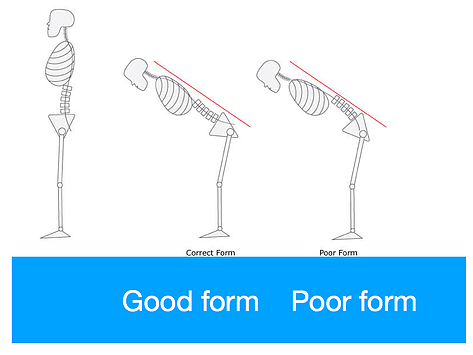
To make it easier to get into a good lifting position the hips have to have enough good mobility. Keeping the hamstrings and gluteal muscles flexible allows the spine to stay still as you hinge at the hips and help prevent rounding in the lower back. Here are three exercises you can try before your class to help prepare the body for movement.
The hamstring extender.
Lay flat on back holding both hands behind the lower thigh. Maintaining a small gap underneath the lower back, tighten front thigh muscles straightening leg to the ceiling. Hold for 5 seconds and relax leg back. Perform 5 times and repeat.
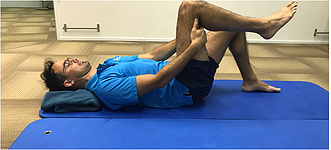
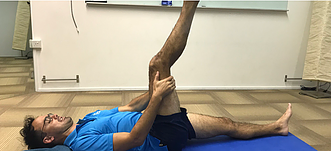
Quadruped rocking
Begin on all fours with small curve in the lower back. Rock your hips back to your heels as far as you can go maintaining the same curve in the lower back.

Dead bugs
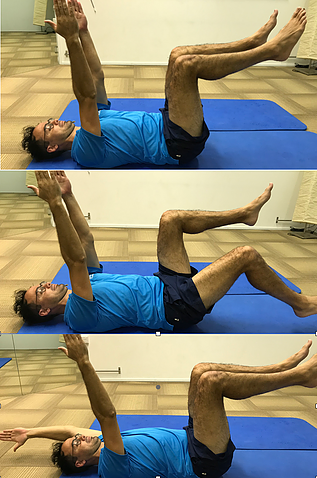
A great exercise for working abdominals and learning how to control movement in the lower spine.
Lay flat on back with small serve underneath the lower back, hips and knees at 90º and arms straight with hands pointing to the ceiling.
Stiffen through your abdominals, exhale and lower one foot at the time to the floor being sure to keep the lower back still. Inhale to return to start position. Alternate between lowering the arms and legs one at a time.
The spine is a very robust and a strong structure that is capable of bearing incredible loads providing those loads are handled correctly. Don’t be afraid to exercise, but if you experience lower back pain during or after exercise seek advice from a professional who can guide you to the best way to approach exercise
Shoulder pain.
Many people will experience shoulder pain in their life and it may not surprise you hear that as we get older the likelihood of experiencing shoulder pain increases. The causes of shoulder pain may vary. From a sudden increase in usage for example putting that overweight carryon luggage in the overhead compartment to not allowing enough time to rest and recover between exercise sessions.
A common pain causing structure in the shoulders are the tendons (connective tissue that attach muscles to bones) of the shoulders. To help prevent tendons becoming painful it is important to get a balance between using the shoulder (tendons like exercise) and rest (they also need rest). Between overhead presses, kettlebell swings, carries and press ups type exercises used in HIIT classes, the amount of stress that goes through shoulders is very high. If you choose to follow a class that includes a lot of exercises on the shoulder, think about taking the next day off from upper body exercises. Rather than more weights, do tennis, swimming or try to go for a run or bicycle ride. This will allow time for the body to go through its natural process of recovery and adaptation (getting stronger ready for the next session) and help avoid overworked tissues in the shoulder that will become painful.
Over head activities of the shoulder can often cause a catching pain or pinching in the shoulder. This can be caused by a variety of reasons, one of which being poor shoulder and upper back mobility. Try these shoulder warm up and mobility exercises before class and see they can help you perform better and reduce the likelihood of pain.
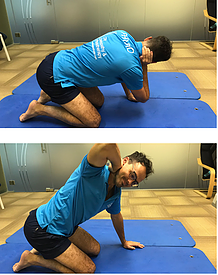
Kneeling upper back rotations
The sedentary nature of many of our lives contributes to a lack of movement in the upper back, something we need for good overhead lifting technique. This exercise works on increasing movement in the upper back.
Rest on all fours with hips resting back onto heels and one hand on the floor and one hand behind the head. Take a breath and rotate chest and sternum towards the supporting elbow, as you exhale turn chest and upper body away from supporting elbow as far as you can, pause and return to start position. Perform 2 sets of 10 on each side.
Contract- relax lats stretch
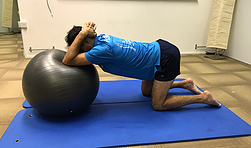
Tight latissimus dorsi (lats) muscles often occur as a result of long periods sat in front of computer and and once tight can be a limiting factor in comfortable overhead exercises. A contract relax stretch is a quick and effective way to stretch a muscle.
In a kneeling position rest elbows on a gym ball or bench and clasp hand behind the head. Lower chest towards the floor until you feel a mild stretch or restriction in the lats or shoulders. Now you are going to contract your lats by pressing your hands together and pressing elbows into the bench. Hold for 8 seconds and relax, now you are relaxed you should find you are able to drop your chest a little lower to the floor before you meet resistance again. Repeat that cycle 3 times and perform 2 sets.
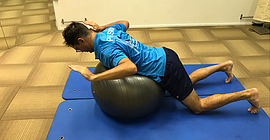
Gym ball W to Ys.
This works as a great mobility and strengthening exercise for the shoulders and upper back.
Lay with chest and lower abdominals on a gym ball with knees bent and feet flat on the floor. Lift arms so forearms are in line with the body and elbows pointing towards feet (the W position). Reach hands forward overhead (the Y position) keeping inline with the body being sure not to let hands drop towards the floor. Return to start position. Perform 2 sets of 10.
Healthy and happy shoulders are easily achievable for people wishing to do HIIT classes. By preparing the muscles and joints for exercise and always building the amount and difficulty of exercise gradually, you can enjoy the rigours of high intensity workouts pain free.
Knee pain
The knee is one of the common injury complaints we get in the clinic from runners, but it is also an issue that is experienced by regular HITT class goers. Exercises like box jumps, burpees and squats put a great deal of stress into the knee joint, which over time can cause pain. A common site of pain in the knee is known as “retro-patella knee pain” or pain that is felt behind the patella (knee cap). Much attention is given to the quadriceps muscle when dealing with knee pain and for good reason, the quadriceps allow for correct movement of knee joint and also the knee cap.
But it is also important to pay attention to strengthening hip and hamstring muscles. The hips play a vital role in helping the knee joint in good alignment (the position of the knee joint relative to the hip and foot) whilst exercising and ensure the knee is stable and well supported.
Common exercises given to strengthen the knees and the hips for example squats or lunges can also be the very movements that cause pain in the knee. So what then? Then it may be a case of looking at how these exercises are being done and what can be changed to make the movements pain free.
Changing the way we perform an exercise can change the muscles that are working and immediately change the pain experienced. Looking at the position of the knee when squatting, jumping or landing may give you some clues as to why you are experiencing pain.
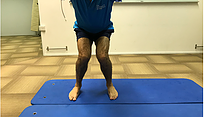
A common movement pattern we see with people with knee pain be it runners, HIIT classes attendees or regular gym goers, is when the knee moves inwards as it bends. This changes the stress and load that goes through the knee and can cause immediate pain.
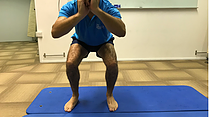
Remind yourself to use your hip muscles during squatting and push the knees out, so they line up over the mid-foot. It’s a simple way to achieve a better, safer squat. Next time you are doing any of these type of exercises take a look in the mirror and check your form.
To make sure your knees can carry you to your next HITT class without pain treat them with care when you get there. Take your time to move well during the class and don’t be tempted to add additional loads until you are confident you have good technique to hop, squat and jump.




